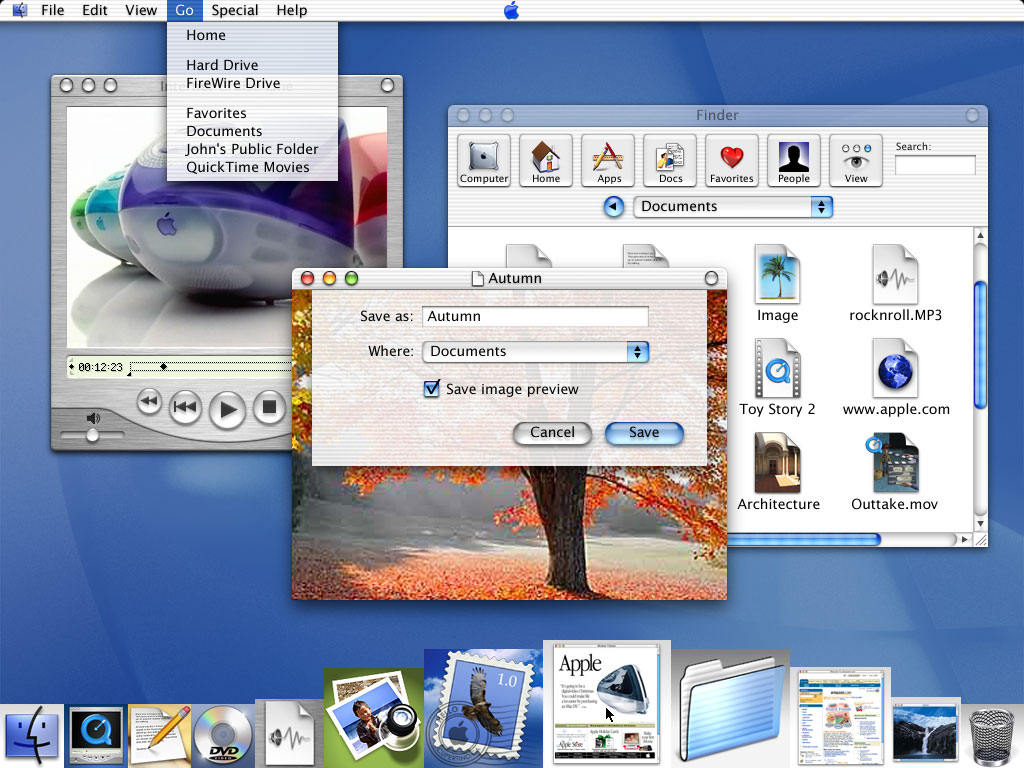MacOS (formerly Mac OS X) is an operating system for Apple Macintosh computers, first released to the public on March 24, 2001, developed by Apple. It is the successor to Mac OS 9, hence the X signifying both its Unix roots and the major release version number 10. As mentioned by Apple, Wikipedia, and others, it is said as Mac OS 10. Mac OS X 10.0 Cheetah Supported Hardware: Power Mac G3 (Desktop, Mini Tower, All-in-One, Blue & White) Power Mac G4 (Yikes, Sawtooth, Gigabit, Digital Audio, QuickSilver requires 10.0.4 build.
(There's no video for QEMU for Windows - PPC emulator, runs Mac OS 9.1, 9.2 + OSX 10.0 to 10.5 yet. Please contribute to MR and add a video now!)

What is QEMU for Windows - PPC emulator, runs Mac OS 9.1, 9.2 + OSX 10.0 to 10.5? QEMU is a very versatile and extremely broadly supported open source virtual machine emulator. In 2016, QEMU could finally achieve what has never been possible before: emulating Mac OS 9.0.4, 9.1 and 9.2.2 (albeit still it's quite slow and the sound support is kind of buggy at the moment). Note that QEMU can also emulate Mac OS X 10.0 up to 10.5. At some point in the near future hopefully, QEMU will fully replace SheepShaver, but at the moment, SheepShaver still runs faster in most situations. Advantages of using QEMU vs SheepShaver:
These bundles were put together by 'that-ben' and are intended to be the easiest possible for beginners. Just launch the 'QEMU - Mac OS 9.2.2.bat' (or 'QEMU - Mac OS X Tiger 10.4.11.bat') file and wait 30 seconds for Mac OS to boot up. Nevermind the yellow screen with a VRAM partition not found error, it will go past this without any problem. The Mac OS 9 package contains a 1GB disk image on which Mac OS 9.2.2 is already fully installed. The Mac OS X package contains Mac OS X 10.4.11. BTW, if you need a larger disk image, you can grab one instantly from here: Blank hard drive disk images (3GB HFS up to 30GB HFS+) Networking is fully functional thanks to the sungem driver that's already pre-configured in these downloads. Right out of the box, it will network through your host machine but on its own subnet branch. The virtual machine's IP will be like 10.0.x.x. Your Windows host IP would likely be something like 192.168.x.x but what's nice is that the virtual machine can still tunnel back to your host machine's subnet branch. So, for instance, you could perfectly well make a server/client environment between Mac OS 9 in QEMU and your Windows host machine. Pre-installed software in the Mac OS 9.2.2 package includes:
Pre-installed software in the Mac OS X 10.4.11 package includes:
See also:Basilisk II - a 68K emulator with floppy support This software's download files include parts. Qemu_(20171224)_-_PPC_-_Mac_OS_X_10.4.11.rar(1197.59 MiB / 1255.76 MB) QEMU (2017/12/15 build) for Windows w/ Mac OS X 10.4.11 pre-installed, RAR'ed / RAR archive 243 / 2018-01-28 / 63bc2a712f342b55ae25eb4397e1f3ad097e71be / / Qemu_(20171224)_-_PPC_-_Mac_OS_X_10.4.11.rar.001(600 MiB / 629.15 MB) SAME AS ABOVE, IN PARTS 15 / 2021-03-31 / 865d29e376c0c323056a11df195cdc595704b970 / / Qemu_(20171224)_-_PPC_-_Mac_OS_X_10.4.11.rar.002(597.59 MiB / 626.62 MB) SAME AS ABOVE, IN PARTS 11 / 2021-03-31 / ea88374ac8151cf846910de85470958db64de662 / / Qemu (20200820) - PPC - Mac OS 9.2.2.rar(147.3 MiB / 154.45 MB) QEMU (2020/08/20 build) for Windows w/ Mac OS 9.2.2 pre-installed / RAR archive 501 / 2020-09-18 / 2021-03-31 / e6da4bca95065b84742d67038bd6c1ab17c00bc4 / / Qemu (20190212) - PPC - Mac OS 9.2.2.rar(125.04 MiB / 131.11 MB) QEMU (2019/02/12 build) for Windows w/ Mac OS 9.2.2 pre-installed / RAR archive 1584 / 2019-03-19 / 2021-03-31 / 16daa6ef096db9391dd15e8a486e6c2648011b22 / / Architecture
This program is for Windows. USEFUL TIPS WHEN USING QEMU:
|
Mac Os X 10.0 Iso
Is your Mac up to date with the latest version of the Mac operating system? Is it using the version required by some product that you want to use with your Mac? Which versions are earlier (older) or later (newer, more recent)? To find out, learn which version is installed now.
If your macOS isn't up to date, you may be able to update to a later version.
Which macOS version is installed?
From the Apple menu in the corner of your screen, choose About This Mac. You should see the macOS name, such as macOS Big Sur, followed by its version number. If you need to know the build number as well, click the version number to see it.
Which macOS version is the latest?
These are all Mac operating systems, starting with the most recent. When a major new macOS is released, it gets a new name, such as macOS Big Sur. As updates that change the macOS version number become available, this article is updated to show the latest version of that macOS.
Mac Os X 10.0 Cheetah
If your Mac is using an earlier version of any Mac operating system, you should install the latest Apple software updates, which can include important security updates and updates for the apps that are installed by macOS, such as Safari, Books, Messages, Mail, Music, Calendar, and Photos.
Mac Os X 10.0 Emulator
| macOS | Latest version |
|---|---|
| macOS Big Sur | 11.2.3 |
| macOS Catalina | 10.15.7 |
| macOS Mojave | 10.14.6 |
| macOS High Sierra | 10.13.6 |
| macOS Sierra | 10.12.6 |
| OS X El Capitan | 10.11.6 |
| OS X Yosemite | 10.10.5 |
| OS X Mavericks | 10.9.5 |
| OS X Mountain Lion | 10.8.5 |
| OS X Lion | 10.7.5 |
| Mac OS X Snow Leopard | 10.6.8 |
| Mac OS X Leopard | 10.5.8 |
| Mac OS X Tiger | 10.4.11 |
| Mac OS X Panther | 10.3.9 |
| Mac OS X Jaguar | 10.2.8 |
| Mac OS X Puma | 10.1.5 |
| Mac OS X Cheetah | 10.0.4 |
